1:30min
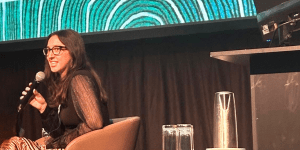 From growing up in the coastal city of Galinyala (Port Lincoln) to setting down roots in Tarndanya (Adelaide), Ngarrindjeri woman Sara Carrison has built an impressive career championing First Nations eye health.
From growing up in the coastal city of Galinyala (Port Lincoln) to setting down roots in Tarndanya (Adelaide), Ngarrindjeri woman Sara Carrison has built an impressive career championing First Nations eye health.
Currently an Associate Lecturer at Flinders University, Sara also serves on the Policy and Education Committee of the Optometry Board of Australia (OptomBA). Between these roles, she dedicates her time to providing outreach services, finding deep fulfilment in her work.
‘The gratitude and appreciation from patients, especially those who have had limited access to eye care, is a powerful reminder of why this work is so important,’ she shared. ‘It has also led me to meet some wonderful people who are incredibly generous with their time, knowledge and personal experiences. Through these interactions, I’ve learned a lot about the communities I’ve visited.’
Sara’s unwavering commitment to enhancing eye health outcomes for Aboriginal and Torres Strait Islander communities was recently recognised at the 2024 National Aboriginal and Torres Strait Islander Eye Health Conference (NATSIEHC24) where she received the Emerging Leader in Aboriginal and Torres Strait Islander Eye Health award.
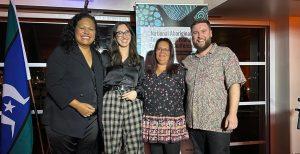
–
‘It took me a few seconds to realise it was my name that had been called out. There are so many people doing such amazing things in this space – the fact that I was even nominated for such an award is an absolute privilege! The award in the past has gone to some deadly recipients, so to be compared to them in such a way is a real honour.
‘Receiving the award gave me a chance to feel proud of what I have accomplished. While I still have much to contribute, it reminded me to appreciate how far I’ve already come. I felt a wave of gratitude, knowing I wouldn’t be where I am without the support and guidance of my family, mentors and colleagues.’
A fortuitous first visit to the optometrist
Growing up, a career in eye health wasn’t initially on Sara’s radar until an unexpected visit to the optometrist changed her path.
‘A family friend of mine became good friends with Phuong Truong, the visiting optometrist in Port Lincoln. Phuong kindly invited me to her store, where she explained optometry to me, and let me use the direct ophthalmoscope where I caught a glimpse of some blood vessels in her eye,’ she said.
‘In high school, I did my work experience at Eyre Eye Centre and discovered I had an optic nerve coloboma. Learning about this condition and more about the anatomy of the eye fuelled my fascination and cemented my decision to pursue optometry as a career.’
Now residing on the land of the Kaurna people with her partner Josh and their two dogs, Zaphie and Sansa, Sara has made Adelaide her home.
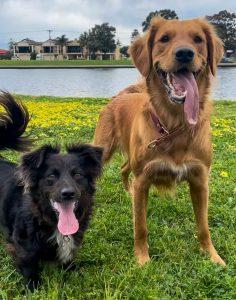
–
‘I’ve made many lifelong friends who’ve helped me find my place in Adelaide. I’ve had the opportunity to work for OPSM, regularly going between Adelaide and Port Lincoln, and occasionally working in Whyalla. After a couple of years, I settled in Glenelg. Reducing the amount of travel gave me the opportunity to join Community Eyecare as a locum optometrist and go up to NT, where I worked in the OPSM in Katherine and Deadly Vision Centre in Larrakia country, Darwin.’
Inspired to make a difference
Motivated by the impactful work of her colleagues and mentors, Sara sought new avenues to contribute meaningfully to First Nations eye health.
‘I started to feel like I wasn’t making a difference to Aboriginal and Torres Strait Islander eye health in the way I would have liked. So, in the last 12 months, I stepped outside my comfort zone and joined the Policy and Education Committee of the Optometry Board of Australia, and more recently, Flinders University as an Associate Lecturer. Although it’s only early days, I’m really enjoying both positions, and am surrounded by such wonderful and supportive people.’
Reflecting on her rewarding career, she highlights her involvement in working on the ‘A Place for Mob and A Place for Me in Optometry’ project with her colleagues Kylie Clarke, Shaun Tatipata and Mitchell Anjou.
‘Working on this project is the first time I’ve been able to merge my passions of optometry and supporting mob in studying optometry. It is such a refreshing space, and every meeting we have fills my cup! I can’t wait to see where the project goes in the future and I hope that it becomes something that provides ongoing support to mob who are interested in, or currently studying, optometry. There was nothing even close to this when I was a student, and I think the ability to be able to connect with mob in a similar situation to you would just be a complete lifeline at times. It’s an important step to helping increase the representation of Aboriginal and Torres Strait Islander people in optometry.’
The importance of First Nations representation
Sara emphasises the importance of First Nations representation in optometry and healthcare, an area that she is extremely passionate about, explaining that it ensures First Nations communities receive culturally safe and relevant care.
‘First Nations health practitioners understand the cultural, social and historical contexts that influence health outcomes for Aboriginal and Torres Strait Islander people. This understanding helps build trust and rapport with patients, leading to better health outcomes,’ she said.
‘Representation also helps address the systemic barriers and biases that exist in the healthcare system. By having First Nations people in decision-making roles, we can advocate for policies and practices that are inclusive and equitable. This helps create a more diverse and culturally competent healthcare workforce, which benefits all patients. Having First Nations role models in healthcare inspires the next generation to pursue careers in this field. It shows young mob that they can achieve their goals and make a difference in their communities. You can’t be what you can’t see!’
Bridging the gap in eye health
To become more culturally aware, Sara suggests actively listening to Aboriginal and Torres Strait Islander people and becoming more self-aware of unconscious bias is a good first step.
‘It’s essential to listen to Aboriginal and Torres Strait Islander people, from individuals to communities and organisations, as we define what cultural safety means to us. This means prioritising our input in the development and implementation of policies and programs, and actively involving us in decision-making processes. Building strong, trust-based relationships with Aboriginal and Torres Strait islander communities is vital, and this requires ongoing communication and collaboration.
‘On a more personal level, you can start by reflecting on your own cultural identity and understand the dominant culture’s norms, values and preferences and how this impacts your world view. This self-awareness helps uncover and address unconscious biases shaped by your environment and experiences. Familiarise yourself with appropriate terminology and culturally significant dates and places. Learn about the land you live and work on, including its traditional owners, language, customs, and history, either online or better yet, at a local cultural centre. Educate yourself on Indigenous healthcare pathways and resources for both you and your patients.’
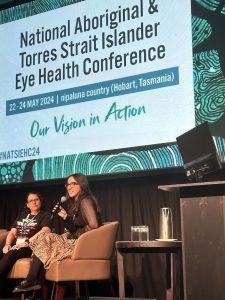
–
Additionally, she recommends developing short- and long-term plans for implementing culturally safe practices, and highlights resources for learning about First Nations eye health.
‘The plan can include undergoing cultural responsiveness and anti-racism training, attending local and national events (i.e., local NAIDOC week events, and conferences like NATSIEHC), connecting and building relationships with Aboriginal and Torres Strait Islander health services. Start small in your practice by consistently asking all patients if they are of Aboriginal or Torres Strait Islander origin. Displaying Indigenous flags and art can create a welcoming environment. Hold yourself and others accountable for promoting inclusivity and diversity in all areas of life and share your learnings with others. Engage in outreach work in Indigenous communities, taking time to understand each community before offering services.
‘There are many resources to explore to learn more, such as the websites and newsletters of Australian Indigenous HealthInfoNet, First Nations Eye Health Alliance (FNEHA), Melbourne University’s Indigenous Eye Health Unit (IEHU), and Indigenous Allied Health Australia (IAHA). If you have the opportunity to do so, join the mob-led conferences such as NATSIEHC and the IAHA National Conference. Get involved in initiatives like the Close the Gap Campaign to contribute to efforts to improve Indigenous health outcomes. Follow Indigenous businesses and health services on social media, such as Clothing the Gap and Weenthunga Health Network, which share fantastic and easy to read resources.’
Advice for aspiring First Nations optometrists
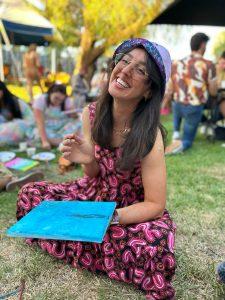 Sara’s advice to the next generation of First Nations people considering a career in optometry is clear: believe in yourself and your potential.
Sara’s advice to the next generation of First Nations people considering a career in optometry is clear: believe in yourself and your potential.
‘While the journey certainly has its challenges, it’s your unique perspectives and experiences that are invaluable,’ she said.
‘If you don’t know where to start, connect with mob in the eye health space and reach out to IAHA or FNEHA – or me! Don’t be afraid to ask for help or guidance when you need it. There are many deadly allies and mob in this space who want to see you succeed, and there are more and more resources becoming available to support you on your journey. Remember that you’re not just doing this for yourself, but for your community, and your footsteps can inspire and guide future generations. Keep pushing forward, seek support when needed, and always believe in yourself and your ability to make a difference.’
Tagged as: Indigenous eye health, members